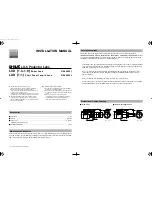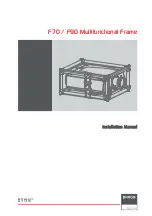
system with a leak check solution.
the air system now contains pressurized air,
which may cause severe eye or ear injury if it is
inadvertently released. Wear appropriate eye and
ear protection before adjusting the air system con-
nections and fittings.
Tighten any fittings, if necessary, and repeat until
all connections are airtight.
4.
Confirm the proper operation of the braking system:
depress and hold the motorhome brake pedal down.
At the towed vehicle, the air cylinder shaft and pedal
clamp will extend. Then, release the brake pedal. The
air cylinder shaft and pedal clamp will retract.
5.
Confirm that the motorhome monitor is function-
ing: the LED will illuminate after the motorhome brake
pedal is depressed, and stop when the brake pedal is
released.
if the leD does not turn on and off as described
above, identify and correct the cause before us-
ing the supplemental braking system. Refer to the
troubleshooting section for possible causes.
the leD is the only indication of braking activ-
ity at the motorhome. Severe damage to the towed
vehicle, a loss of vehicular control, or other con-
sequential, non-warranty damage can occur if the
driver of the motorhome is unaware that the sup-
plemental braking system is not functioning prop-
erly.
failure to follow these instructions may cause
property damage, personal injury or even death.
6.
Confirm the proper operation of the break away
system —
First, charge the break away air reservoir — with the
motorhome engine on, the air compressor completely
charged and the parking brake released, depress the
brake pedal for 15 seconds — apply firm pressure.
the break away air reservoir must be charged,
as described above, every time the motorhome and
towed vehicle are connected.
if the air reservoir is not charged, the break away
system will not apply braking pressure if the towed
vehicle separates from the motorhome, which may
cause property damage, personal injury or even
death.
continued on next page
SyStem teSt
Always deplete the stored vacuum in the towed
vehicle’s power brake system before towing — pump
the brake pedal several times.
Depending on the make and model of the towed
vehicle, it may be necessary to pump the brake
pedal repeatedly to deplete the vacuum.
if the vacuum is not released, the supplemental
braking system will apply excessive braking force
when it is activated, which will cause severe tire
and/or brake system damage to the towed vehi-
cle.
1.
The motorhome and towed vehicle must be station-
ary for the system test, and ready for towing…
•
Connect and attach the tow bar to the motorhome
and towed vehicle.
•
According to the manufacturer, make all adjustments
necessary to prepare the vehicle for towing. These ad-
justments may include: turning the ignition key to the
“tow” position; pulling fuses; disconnecting the battery;
and setting the transmission to a particular gear or in
a particular sequence.
to prevent the towed vehicle from rolling, con-
nect and attach the tow bar to both vehicles before
shifting the towed vehicle’s transmission into the
proper gear for towing.
•
Connect the patch cord between the two vehicles
— both the air line quick couplers and the motorhome
monitor bullet connectors — see Step Four, “Connect the
patch cord between the motorhome and the towed ve-
hicle,” under “Install the motorhome monitor system.”
•
Attach the air cylinder to the brake pedal and mount-
ing post (or seat bracket adaptor) — see “Install the air
cylinder anchor plate.” Connect the male quick coupler
at the end of the air line on the air cylinder to the female
quick coupler at the end of the air line mounted in the
passenger compartment.
•
Clip one end of the steel break away cable to the
break away pin (Figure 7); clip the other end of the
cable to the rear of the motorhome, close to the cen-
ter.
2.
Block the motorhome’s wheels, then release the
parking brake. Turn the motorhome engine on, and
leave it running.
3.
After the air brake system is completely charged,
check for leaks in the air system: Have an assistant
apply the motorhome brakes and continue to hold the
brake pedal down.
Cover each joint, fitting and connection in the air
14
Summary of Contents for BrakeMaster 9100
Page 4: ...2...









































